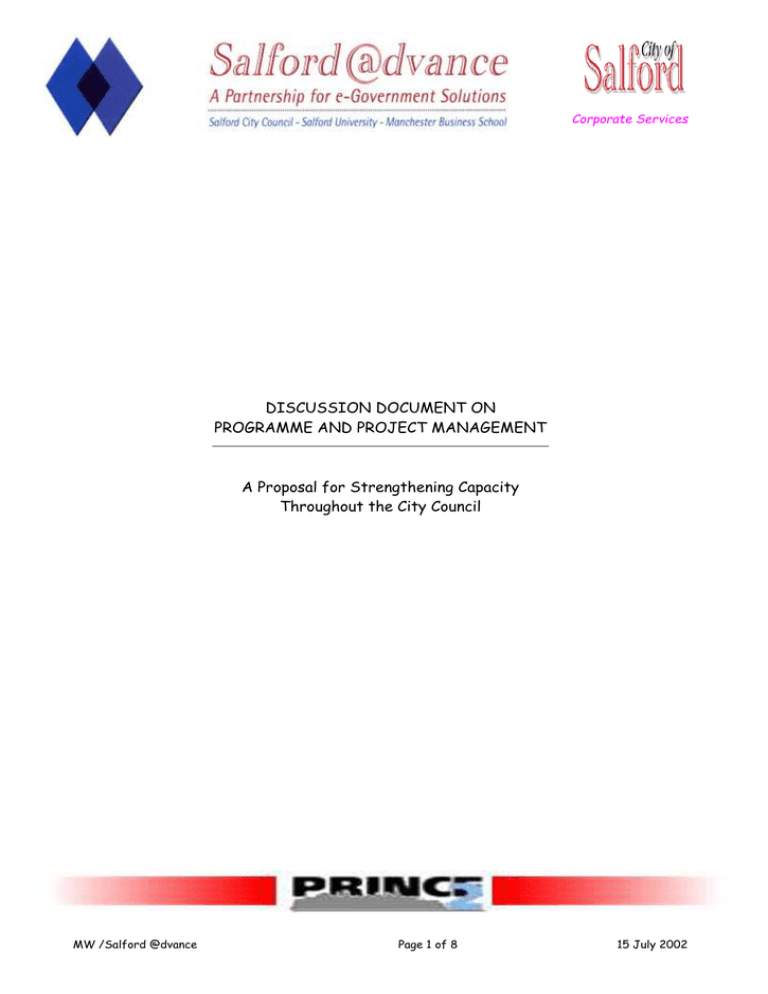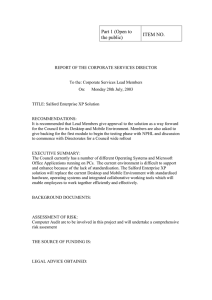DISCUSSION DOCUMENT ON PROGRAMME AND PROJECT MANAGEMENT A Proposal for Strengthening Capacity
advertisement

Corporate Services DISCUSSION DOCUMENT ON PROGRAMME AND PROJECT MANAGEMENT A Proposal for Strengthening Capacity Throughout the City Council MW /Salford @dvance Page 1 of 8 15 July 2002 1. INTRODUCTION Effective Programme and Project Management is widely regarded as a crucial factor in the success of the National Modernising Agenda and the Council’s Change Programmes. Indeed the recent report by the Best Value inspectorate referred to this factor to ensure successful Best Value review outcomes for the future A lot of good work has already been done within Corporate Services, in developing project management capacity, with the introduction of sound standards, methods and tools and the development of skills and supporting facilities. This document describes the achievements to date and sets out proposals to further strengthen and disseminate good practice throughout the City Council 2. WHERE ARE WE NOW? Over the past eighteen months or so, the following project management capacity has been developed within Salford @dvance: PRINCE 2 * has been formally adopted as the management methodology, tailored to suit Salford’s particular needs, including documentation, planning templates, structures, controls and reporting protocols. Such standards have been applied to both the development of e-Government Pathfinder products and new software development projects during 2001/2 A Project Support Office has been established, involving two senior officers from within existing resources, whose role is to assist with project planning, tracking, administration and support. The full role is described in Appendix 2 A Project Manager has been appointed from the private sector, initially engaged on the e-Government programme and more recently to manage the Broadband strategy for schools, adding substantially to the skills base A Support Officer is being appointed to provide training and support Supporting facilities have been devised through the creation of a dedicated intranet site, providing details of the Salford version of PRINCE 2, project documentation, case studies and progress reports on live projects Computer Based Training (CBT) CD ROM facilities have been acquired and installed on a corporate server which provides access to training materials on general project management techniques and PRINCE 2 standards * An overview of PRINCE 2 is provided at Appendix 1 MW /Salford @dvance Page 2 of 8 15 July 2002 An In- House Training course has been developed which covers Salford specific tailored PRINCE 2 content in readiness for delivery in September Initial awareness training of 16 staff and elected members has been carried out as part of Pathfinder Project 6 staff have passed PRINCE 2 Foundation examination and 2 to practitioner level A supporting project planning tool (Microsoft Project 2000) has been acquired and installed to aid planning, tracking and reporting and an in-house training course developed in it’s use in readiness for delivery in quarter 3 The product `Sharepoint Portal Server’ has been acquired and implemented which will provide the facilities for efficient version control, security, editing and publication of project documentation Handbook on Good Practice and Policy Guide on Standards produced and circulated to some Directorates Mentored several Local Authorities on good Project Management practice as part of Pathfinder Project 3. WHAT HAVE BEEN THE BENEFITS? Whilst it is relatively early to draw full conclusions from this initial capacity building work, early signs have shown that projects subject to PRINCE 2 standards are better scoped, planned, controlled and communicated, leading to a better understanding of targets and tasks, ultimately resulting in a greater degree of success in project delivery in accordance with expectations. This is particularly exemplified by the success of e-Government Pathfinder Projects MW /Salford @dvance Page 3 of 8 15 July 2002 4. HOW COULD WE FURTHER STRENGTHEN THE POSITION? It is felt that progress to date could be more broadly exploited throughout the Council and that we should introduce further initiatives to build on this initial work, by further developing the following three building blocks: Fig. 1 Key capacity building measures Based within Salford @dvance and branded `PriMA’, this would involve the creation of a Project Management Academy, by which to develop and support widespread skills capacity- building and good practice. The specific role of the academy would be to: Provide a focal point for the development of excellence in the discipline of Project Management, including: Identification, planning and delivery of training Development of a user group for dissemination and mentoring of good practice Provide general advice, guidance and support to project managers Development and maintenance of standards, methods and techniques relative to Salford’s specific needs and project management approach Development of a portfolio approach which will recognise the need for varying levels of expertise in the subject, involving basic, intermediate and advanced skill sets which reflect the range of simple, medium and complex projects arising from Council programmes MW /Salford @dvance Page 4 of 8 15 July 2002 This entails the corporate adoption of a Salford tailored version of PRINCE 2 as the chosen Project Management standard throughout the Council. Much good work has already been done in adapting this standard to the specific needs of Salford, based on the work for the Pathfinder Projects. Through the work of the academy above and the role of the Project Support Office described below, a programme of rollout within the Council would be devised, which reflected the priorities of each Directorate, to gradually build the long- term capacity needed, beginning in 2002/3. This work would begin with the adoption of a set of policy standards, followed by training and then pilot work on agreed projects This involves the positioning of the current Project Support Office within Salford @dvance such that it provides services and support to other Service Directorates, in accordance with the role described in appendix 2. Clearly, a key consideration here is the resource implications and organisational arrangements, which would need to be addressed once the scale of take-up is more clearly known 5. WHAT NEXT? It is important that there is a serious corporate commitment to the proposals in this discussion paper if they are to work and a clear mandate to progress things in conjunction with Service Directorates. It is proposed therefore that this document be circulated for consultation throughout Directorates as a first step in assessing needs and likely take-up MW /Salford @dvance Page 5 of 8 15 July 2002 Appendix 1 OVERVIEW OF PRINCE 2 WHY STRUCTURED PROJECT MANAGEMENT? More Reliable Delivery Better Use of Resources Best Value / Best Practice `Earned Autonomy ’ from more reliable delivery and performance Key Feature of Change Management WHAT IS PRINCE 2? PRINCE - PRojects IN Controlled Environment Framework for Project Planning and Management De facto Standard in Public and Private Sectors Proven Best Practice All Project types – Not just IT KEY FEATURES: Focus on Business Justification Defined Organisational Team Structure Clear Roles and Responsibilities Emphasis on Products and Deliverables Emphasis on Manageable Stages Management by exception based on clear- set tolerances Adaptable dependent on size and complexity of projects PROVIDES PROJECTS WITH: Controlled Start, middle and end Regular reviews against plan Regular review against Business Case Clear decision points Control of changes to and deviations from plan which may create risks Control of Risks Involvement of all stakeholders Effective Communication Channels MW /Salford @dvance Page 6 of 8 15 July 2002 ENABLES PROJECT MANAGERS TO: Establish clear Terms of Reference Use a defined structure for Decisions Better planning and control through Stages Ensure Resource Commitments Provide regular Management Reporting ENABLES ALL STAKEHOLDERS TO: Effectively Participate in Projects Participate in Quality checks Ensure Requirements are Met TYPICAL PROJECT TEAM STRUCTURE INVOLVES: Project Board: Executive, Senior User, Senior Supplier Project Manager Project Assurance Project Support KEY CONTROLS AND DOCUMENTATION: Project Mandate / Business Case Project Initiation Document (PID) Project Plan / Stage Plan Communication Plan Risk Log / Issues Log Exception Report Highlight Report End Stage Report Lessons Learnt Report End Project Report MW /Salford @dvance Page 7 of 8 15 July 2002 Appendix 2 ROLE OF PROJECT SUPPORT OFFICE FUNCTIONS PROJECT PLANNING PROJECT MANAGEMENT & ADMINISTRATION ACTIVITIES QUALITY CONTROL SECRETARIAT MW /Salford @dvance Set & maintain standards for programme and project planning Advise on planning techniques and use of planning software (MS2000) Guide and support project managers in project planning and estimating Monitor and track project milestones and deliverables Maintain Integrated Programme plan Update overall plan with actuals and Report on plan Status Develop and maintain Salford version o PRINCE 2 standards Set-up and maintain programme filing system Maintain programme logs and registers (Risks, Issues, lessons learned, and Exceptions) Progress and analyse exceptions and prepare status reports Be responsible for the provision of relevant programme and project management training (Prince 2, MS2000) Schedule and arrange formal project reviews Collate regular progress reports and regular Information from constituent projects Provide a centre of expertise in the use of Prince 2 and planning and control software Ensure risk assessment and management processes are carried out Advise and assist project Managers in establishing project quality and test plans Schedule Quality reviews and audits Prepare / maintain filing and retrieval of programme documentation Ensure communication standards are maintained Provide a filing and document production service Provide first link for programme information requirements from either within or outside the programme Page 8 of 8 15 July 2002

